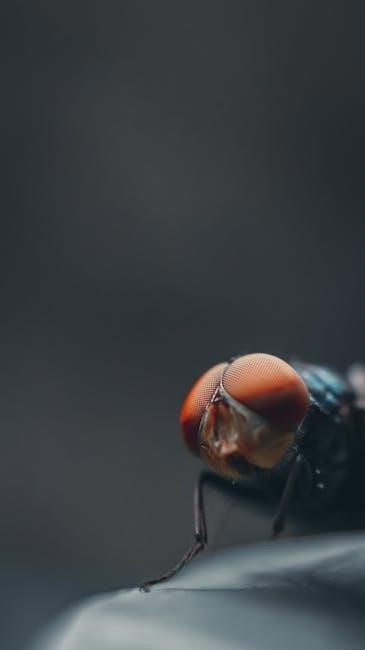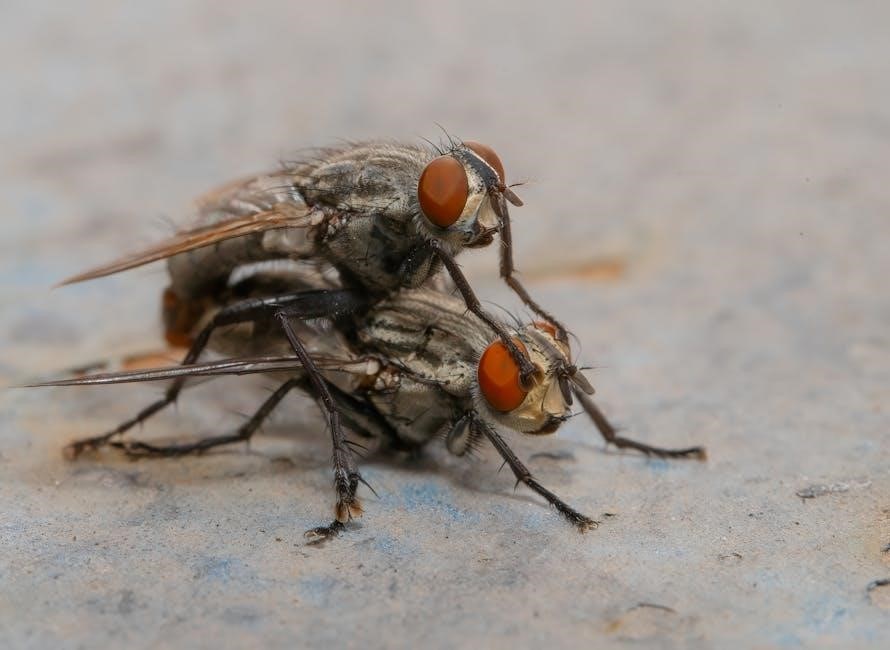The life cycle of a housefly is a biological process consisting of four stages: egg, larva, pupa, and adult. It typically lasts 10-45 days, depending on environmental factors like temperature and nutrition. Understanding this cycle is crucial for effective management strategies.

Egg Stage
House fly eggs are elongated, yellowish-white ovals, approximately 1 mm long. Females lay clusters of 100-150 eggs in nutrient-rich environments, such as decaying organic matter. Eggs hatch within 24 hours into larvae.
Physical Description
House fly eggs are elongated, yellowish-white ovals, typically measuring about 1 mm in length. They are smooth and slightly ribbed, with a rounded tip at one end and a flatter surface at the other. Females often lay eggs in clusters, ensuring optimal conditions for development. The eggs are usually deposited in nutrient-rich substrates, such as decaying organic matter, where they can absorb moisture and nutrients essential for hatching. Their small size and pale coloration make them difficult to detect without close inspection. The surface of the eggs is smooth, lacking any distinct markings or patterns, which helps them blend into their surroundings. This physical description is crucial for identifying house fly eggs in various environments, aiding in pest control and management strategies.

Egg-Laying Sites
House flies typically lay their eggs in nutrient-rich, decaying organic matter, such as garbage, manure, compost, or rotting food. Females prefer warm, moist environments for egg deposition, as these conditions promote rapid hatching and larval growth. The eggs are often deposited in clusters, ensuring that the emerging larvae have an ample food source. Common egg-laying sites include animal waste, vegetable peels, and other decomposing materials. The female house fly is highly selective in choosing egg-laying sites, favoring locations with the right consistency and humidity to support the development of the eggs. This behavior ensures the survival and success of the next generation. Understanding these preferences is key to implementing effective pest control measures, as eliminating potential egg-laying sites can significantly reduce house fly populations.

Larval Stage
The larval stage lasts 4-13 days, during which maggots undergo three instars. They feed on organic matter, breaking it down to support growth. This stage is crucial for development before transforming into pupae.
Maggots
Maggots are the larval stage of houseflies, appearing as small, yellowish-white, legless creatures with a distinct head. They emerge from eggs after a short hatching period and are voracious feeders, consuming decaying organic matter to sustain growth. Maggots lack eyes and limbs but are highly efficient at breaking down their food sources, which aids in nutrient recycling. During this stage, they undergo three instars, or growth phases, shedding their skin as they increase in size. The larval stage typically lasts between 4-13 days, depending on environmental factors such as temperature and food availability. Maggots are crucial in the decomposition process and play a significant role in the ecosystem. As they mature, they begin to seek a dry, sheltered location to pupate, marking the end of the larval stage and the transition to the next phase of their life cycle.
Instars
Instars represent the distinct growth stages within the larval phase of a housefly’s life cycle. Housefly larvae, or maggots, undergo three instars, each characterized by molting (shedding of the skin) as they grow. The first instar emerges from the egg and is the smallest, while the third instar is the largest and most developed. Each instar lasts several days, with the total larval stage typically spanning 4-13 days, depending on environmental conditions such as temperature and food availability. During these instars, maggots focus on feeding and accumulating energy for the next stage of their development. The instars are critical for the larva’s growth and preparation for pupation. Understanding the instars is essential for grasping the biological processes that drive the housefly’s life cycle and for developing effective pest management strategies. This stage highlights the adaptability of houseflies to various environments, enabling their rapid proliferation in diverse settings.
Behavior
During the larval stage, housefly maggots exhibit specific behaviors that aid their survival and development. They are attracted to decaying organic matter, where they feed voraciously to accumulate energy for growth. Maggots are capable of moving toward food sources, guided by chemical cues, and they often cluster together in large groups. This aggregation behavior may enhance feeding efficiency or provide protection from predators. The larvae are also known to burrow into their food substrate, which helps them access nutrients more effectively. Environmental factors, such as temperature and moisture, significantly influence the activity and movement of maggots. Warmer conditions generally increase their activity, while cooler temperatures slow it down. This behavior ensures that the larvae can optimize their growth and prepare for the pupal stage. Understanding the behavioral patterns of housefly larvae is crucial for developing strategies to disrupt their life cycle and control infestations effectively.

Pupal Stage
The pupal stage lasts about 3-4 days, during which the larva transforms into an adult within a protective cocoon. Warmer temperatures accelerate this process, ensuring rapid development.
Transformation
The pupal stage is a critical phase in the housefly life cycle, marked by dramatic physiological changes. During this period, the larva transforms into a fully formed adult fly within a protective puparium. The puparium is formed from the larval skin, creating a sheltered environment for metamorphosis. Inside, the larval tissues break down and reorganize into adult structures, including wings, eyes, and reproductive organs. This transformation is fueled by energy reserves accumulated during the larval stage. Environmental factors, such as temperature and humidity, significantly influence the duration and success of this process. Typically lasting 3-4 days, the pupal stage concludes when the adult fly emerges, its body fully developed and ready for reproduction. This stage is essential for the continuation of the species, as it ensures the transition from a legless, feeding larva to a flying, reproducing adult. Understanding this transformation is key to grasping the housefly’s life cycle dynamics.
Adult Stage
The adult stage is the final phase of the housefly life cycle; Emerging fully formed, adult flies are ready to reproduce and begin the cycle anew. Their lifespan typically ranges from 3-4 weeks, influenced by environmental factors like temperature and nutrition.
Physical Features
Adult houseflies have distinct physical features that enable them to thrive. They are approximately 5-8 millimeters in length, with a stout, oval-shaped body. Their color varies from gray to black, often with a metallic sheen. Females are slightly larger than males. Houseflies have two large, compound eyes that cover most of their head, providing excellent vision. They also have a pair of smaller, simple eyes. Their wings are translucent and slightly hairy, aiding in flight. Notably, houseflies lack teeth or a stinger, relying instead on a spongy, extendable mouthpart called a proboscis for feeding. Males have a more slender abdomen compared to females. Antennae are short and feathery, aiding in sensory perception. These features collectively make the housefly a highly adaptable and efficient insect, capable of exploiting various environments for survival and reproduction.
Reproduction
Reproduction is a critical aspect of the housefly life cycle, ensuring the continuation of the species. Adult houseflies mate shortly after emerging from the pupal stage, typically within 24 hours. Males engage in courtship behaviors to attract females, often involving flight patterns and pheromones. Females are capable of storing sperm from multiple males, allowing them to control fertilization of their eggs. A single female housefly can lay up to 100-150 eggs in a single clutch, often in decaying organic matter or nutrient-rich substrates. The eggs hatch into larvae within 24 hours, initiating the next stage of the life cycle. Environmental factors such as temperature, humidity, and food availability significantly influence reproductive success. Females may lay multiple batches of eggs during their lifespan, further enhancing the species’ reproductive potential. This efficient reproductive strategy contributes to the housefly’s ability to rapidly colonize new areas and adapt to diverse environments.

Lifespan
The average lifespan of a housefly is typically 3-4 weeks, although this can vary depending on environmental factors such as temperature, nutrition, and exposure to predators or pesticides. In optimal conditions, some houseflies may live up to 6 weeks. Factors such as food availability and climate play a significant role in determining their lifespan. Warmer temperatures generally shorten their lifespan, while cooler conditions can extend it. Houseflies are most active during daylight hours, particularly when temperatures are between 80°F and 90°F (27°C and 32°C). At night, they become less active, especially if temperatures drop below 45°F (7°C). Their lifespan is also influenced by their stage of development, as they spend a portion of their life cycle in the larval and pupal stages before reaching adulthood. Understanding the lifespan is crucial for managing fly populations effectively, as it helps predict their activity patterns and potential for reproduction.


